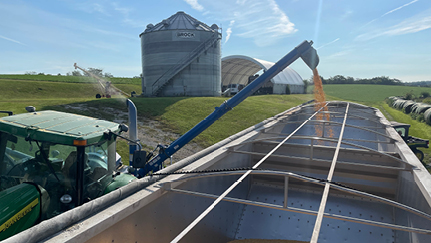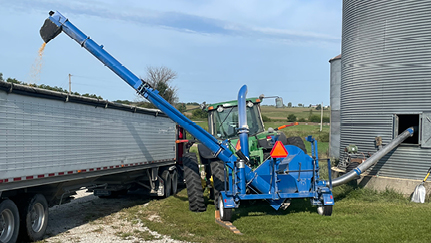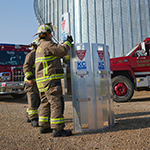Grain Vacuum Safety Tips

Grain vacuums, commonly known as grain vacs, are indispensable in grain handling facilities. They excel at cleaning up grain spills, emptying bins with malfunctioning unloading equipment, and finishing off cleaning tasks. A single grain vac can replace the work of numerous sweep augers and countless shovels. While their design allows operators to move large volumes of grain with minimal effort, grain vacs also present unique safety challenges.
Noise
Grain vacs generate significant noise levels. Anyone nearby should wear hearing protection, even if they are inside the cab of a truck or tractor. The noise makes verbal communication nearly impossible, so workers need a direct line of sight to use hand signals effectively.
Dust
The grain vac's powerful suction pulls in everything in front of the hose, including dust particles separated from the grain and expelled through the exhaust chute. This creates a large, continuous cloud of dust, which can obscure visibility and pose additional hazards.
Entanglement
Many grain vacs are powered by a tractor's power take-off (PTO), which involves a four- to five-foot-long shaft spinning at 1,000 RPM (16 times per second). PTO entanglement has historically caused amputations and fatalities. Machine guards can mitigate this risk by creating a barrier around the spinning shaft, but any active PTO remains dangerous. If guards are temporarily removed or adjusted for maintenance, they must be reinstalled correctly before use. Additionally, the grain vac nozzle itself poses a danger due to its powerful suction, capable of pulling in anything in its path.
Grain entrapment
Grain vacs are designed to move large volumes of grain quickly. When the nozzle is placed into the grain, it creates a zone of rapidly moving grains. This can lead to the formation of pits or grain avalanches within seconds. The speed and volume of grain movement around the vac nozzle can make it more hazardous than an unloading auger in terms of grain entrapment.
Follow these safety tips when working in and around a grain vac

- Always work with a partner.
- Wear hearing protection and appropriate protective clothing or personal protective equipment (PPE).
- Agree upon nonverbal communication before starting and maintain line of sight between workers.
- Take PTO safety seriously. Never cross the shaft and maintain a minimum distance (twice the operator’s height) from the PTO when equipment is running. Keep guards in place and in good condition.
- Whenever possible operate or monitor a grain vac from outside of the bin.
- Shut down the vac to add hose sections or reposition the nozzle as needed.
- Follow all grain vac manufacturer operational instructions.
- Do not attempt to suck up or move burning grain with a grain vac.
- Use this guide for formal discussions with farm workers and help raise awareness about grain vacuum safety.
References
Iowa State University Extension and Outreach. “Grain Handling Equipment Safety,” 2023.

 >
>

 >
>
 >
>